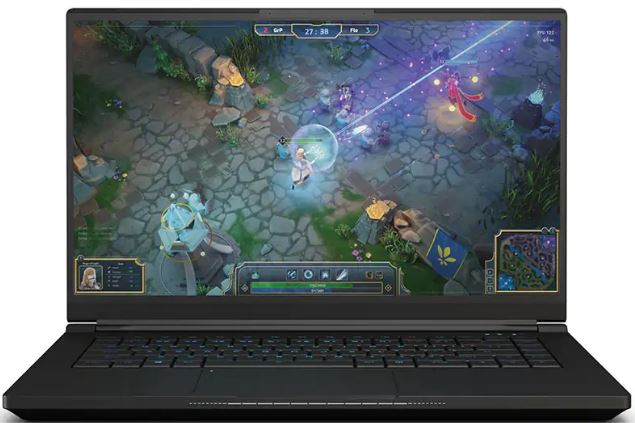Intel LAPAC71G X15 Laptop Kit User Guide

intel LAPAC71G X15 Laptop Ki


- Connect the power cord to the AC adapter then to a grounded 100-240VAC outlet.
- Connect the AC adapter’s DC output plug to the DC IN jack on the right side of the system.
- The display panel can be opened to a wide range of angles for optimal viewing.
- Attempting to force the lid open beyond 135 degrees will cause damage to the hinges and/or the display.
- Press the power button to turn on your laptop computer.
Product Overview
US Keyboard
- Digital Microphones
Dual built-in microphones - Infrared LED
Used to support Windows Hello feature - Camera
High Definition Camera - Blue LED
Camera Activity Indicator - LCD Screen
Internal display/panel - Power Button and Power LED
Press once to turn the laptop on when it is powered off or asleep. Indicator will turn on. Press once to notify the operating system to power off the laptop or enter sleep mode. Indicator will turn off if powered off.- Power On: White
- Power Off: Off
- Suspend: Breathing White
- Keyboard
Membrane Keyboard with single zone RGB Backlight - Touchpad Enable/Disable Switch with Indicator
- Double-tap to enable or disable the touchpad.
- The indicator will turn on when the touchpad is disabled.
- Touchpad/Clickpad
Touch-sensitive pointing device which functions like a mouse - Caps Lock Status Indicator
- Caps Lock ON: Indicator On
- Caps Lock OFF: Indicator Off
Right Side
- Thunderbolt™ 4 Port
Connect any USB Type C or Thunderbolt™ device into this port, such as a USB Flash drive or an external storage device. This port will also support displays using a Type-C to DisplayPort cable. - USB 3.2 Gen2 Port Connect any USB device into this port, such as a USB flash drive, keyboard, or mouse.
- HDMI 2.1 Port Supports high-definition digital video connections
- Power Connector Connect the AC adapter into this connector
Left Side
- Kensington Lock Anti-theft key lock hole
- Network Jack (RJ-45) This jack lets you connect to a Local Area Network (LAN)
- USB 3.2 Gen2 Port Connect any USB device into this port, such as a USB flash drive, keyboard, or mouse.
- Headset Jack Connect amplified speakers or headphones into this jack
Bottom Side
- Speakers Stereo audio output
- Back Cover Screws Modification of any of the laptop’s components will void the warranty
- Vents The thermal vents are designed to cool the internal components and avoid overheating
Back Side
Understanding the Keyboard
The following defines the row of function keys which also contain secondary hotkeys/shortcuts which can be accessed by pressing and holding down the Function Key (FN) while simultaneously pressing the desired hotkey/shortcut.
Keyboard Shortcuts
To activate these functions, press the hotkey associated with the desired function as indicated below:
Using the Touchpad/Clickpad
The touchpad / clickpad is a rectangular electronic panel located just below your keyboard. Clicking twice within the 15mm x 15mm corner in the top left will enable or disable (lighted indicator) touchpad functionality. You can slide your finger on the static-sensitive panel of the touchpad / clickpad to move the cursor.
Press the left and right bottom corners located on the bottom edge of the touchpad / clickpad to make selections and run functions. These two buttons are similar to the left and right buttons on a mouse. Tapping on the touchpad / clickpad produces similar results.
INFORMATION IN THIS DOCUMENT IS PROVIDED IN CONNECTION WITH INTEL® PRODUCTS.
NO LICENSE, EXPRESS OR IMPLIED, BY ESTOPPEL OR OTHERWISE, TO ANY INTELLECTUAL PROPERTY RIGHTS IS GRANTED BY THIS DOCUMENT. EXCEPT AS PROVIDED IN INTEL’S
TERMS AND CONDITIONS OF SALE FOR SUCH PRODUCTS, INTEL ASSUMES NO LIABILITY WHATSOEVER, AND INTEL DISCLAIMS ANY EXPRESS OR IMPLIED WARRANTY, RELATING
TO SELL AND/OR USE OF INTEL PRODUCTS INCLUDING LIABILITY OR WARRANTIES
RELATING TO FITNESS FOR A PARTICULAR PURPOSE, MERCHANTABILITY, OR INFRINGEMENT
OF ANY PATENT, COPYRIGHT OR OTHER INTELLECTUAL PROPERTY RIGHT.
Intel products are not intended for use in medical, life saving, or life sustaining applications.
Intel may make changes to specifications and product descriptions at any time, without notice. Intel products may contain design defects or errors known as errata which may cause the product
to deviate from published specifications. Current characterized errata are available on request.
The SuperSpeed USB Trident® logo is a registered trademark owned by USB Implementers Forum, Inc. and any use of such mark by Intel Corporation is under license.
The terms HDMI and HDMI High-Definition Multimedia Inferface, and the HDMI Logo are trademarks or registered trademarks of HDMI Licensing LLC in the United States and other countries.
Intel and the Intel logo are trademarks of Intel Corporation in the United States and/or other countries.
* Other names and brands may be claimed as the property of others.
Copyright © 2022, Intel Corporation. All rights reserved.